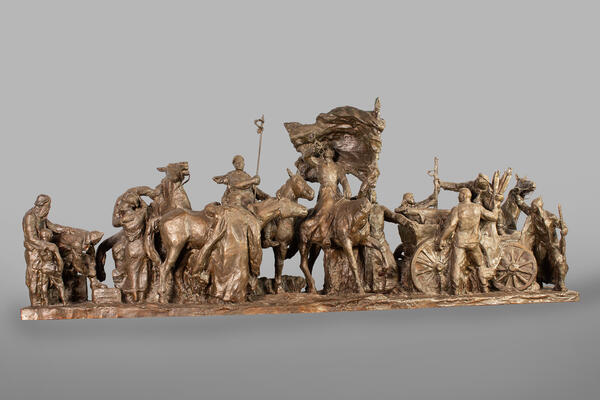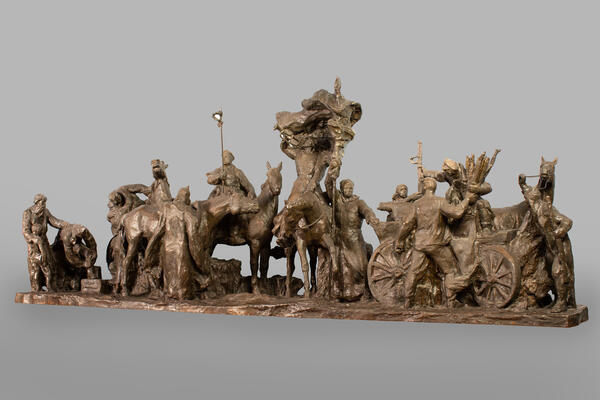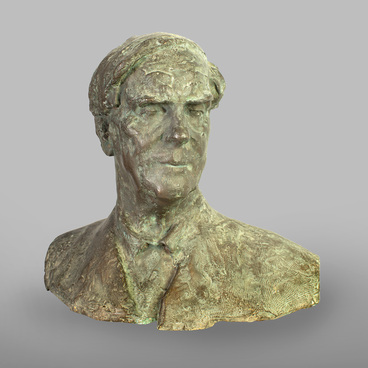The Tambov Regional Art Gallery houses the work “Marching off” by Mikhail Arkadyevich Neimark. The sculptural composition, divided into several groups, reveals the theme of citizenship and heroism in revolutionary Russia.
In the center of the composition is a Red Army fighter in an overcoat and budyonovka, on horseback, blowing a horn to call a detachment for a campaign. To the left of the horn blower is a standard-bearer, who holds a staff of a fluttering banner while leaning on the edge of a machine-gun cart (“tachanka”) surrounded by figures of four more fighters. Two people standing around (a girl on the right side of the tachanka, and a young man on the left) take rifles from the driver, who distributes arms to the fighters. The figure of the Red Army fighter on the far right seems to close the compositional circle. The fighter leads a horse by the bridle to harness it to the cart. To the right of the horn blower is a group of three cavalrymen. The fighter closest to the figure of the horn blower sits on horseback with a long pike in his hands. The other fighter is about to mount the horse, his arms wrapped around the saddle. His head is turned to the right, his eyes fixed on his comrade, who, hanging down from the saddle, embraces a girl, bidding her farewell. The composition is closed by a group of three people: an old man with a boy, seeing off another soldier who sits with his face down and adjusts the gear with his hands.
Without claiming fundamentally new ways of revealing the military theme, Neimark’s work reflects the creator’s sharp emotional vision. The sculptor’s main objective was to show a wartime man as close to real life as possible.
Mikhail Arkadyevich Neimark was born on September 9, 1927, in Rostov-on-Don into the family of a diplomat. He graduated from the Moscow Higher School of Design and Applied Art (former Stroganov School), Department of Monumental Sculpture. In 1956, he became a member of the Union of Artists of the USSR. The beginning of his career was typical for the young and daring “Sixtiers” who were looking for new ways in Soviet art after the triumphs of Stalin’s socialist realism. Their manner was a challenge to the pompous pseudo-classics of the then academic luminaries. In contrast, Neimark adopted and mastered a language of sculpture that combined the compositional constructiveness coming from Alexander Matveyev in Russian plastic art of the 20th century with sharper forms, post-cubist expression, and dynamics that captivated the young Vera Mukhina, Boris Korolyov, and Joseph Chaikov.
In the center of the composition is a Red Army fighter in an overcoat and budyonovka, on horseback, blowing a horn to call a detachment for a campaign. To the left of the horn blower is a standard-bearer, who holds a staff of a fluttering banner while leaning on the edge of a machine-gun cart (“tachanka”) surrounded by figures of four more fighters. Two people standing around (a girl on the right side of the tachanka, and a young man on the left) take rifles from the driver, who distributes arms to the fighters. The figure of the Red Army fighter on the far right seems to close the compositional circle. The fighter leads a horse by the bridle to harness it to the cart. To the right of the horn blower is a group of three cavalrymen. The fighter closest to the figure of the horn blower sits on horseback with a long pike in his hands. The other fighter is about to mount the horse, his arms wrapped around the saddle. His head is turned to the right, his eyes fixed on his comrade, who, hanging down from the saddle, embraces a girl, bidding her farewell. The composition is closed by a group of three people: an old man with a boy, seeing off another soldier who sits with his face down and adjusts the gear with his hands.
Without claiming fundamentally new ways of revealing the military theme, Neimark’s work reflects the creator’s sharp emotional vision. The sculptor’s main objective was to show a wartime man as close to real life as possible.
Mikhail Arkadyevich Neimark was born on September 9, 1927, in Rostov-on-Don into the family of a diplomat. He graduated from the Moscow Higher School of Design and Applied Art (former Stroganov School), Department of Monumental Sculpture. In 1956, he became a member of the Union of Artists of the USSR. The beginning of his career was typical for the young and daring “Sixtiers” who were looking for new ways in Soviet art after the triumphs of Stalin’s socialist realism. Their manner was a challenge to the pompous pseudo-classics of the then academic luminaries. In contrast, Neimark adopted and mastered a language of sculpture that combined the compositional constructiveness coming from Alexander Matveyev in Russian plastic art of the 20th century with sharper forms, post-cubist expression, and dynamics that captivated the young Vera Mukhina, Boris Korolyov, and Joseph Chaikov.





